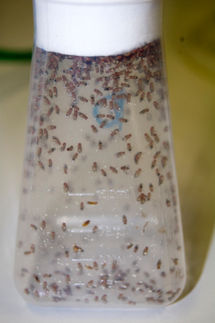Poplar DNA code cracked new possibilities for sustainable energy
Sustainable or renewable energy in the form of bio-ethanol, for example can be produced for us by trees. Now, an international consortium, which includes researchers from the Flanders Interuniversity Institute for biotechnology (VIB) at Ghent University, has succeeded in unraveling the first tree genome that of the poplar. Moreover, their research indicates that the poplar has about 45,000 genes. This knowledge is a first step toward being able to make trees grow faster or make them easier to process into paper or energy.
It's difficult to overestimate the importance of trees as providers of clean air as well as raw material for bio-energy, paper, furniture and other useful objects. A lot of the properties that trees possess are not found in other plants, like their abilities to produce large quantities of wood, to synchronize their growth with the seasons, and to adapt to changing environmental conditions. They need these properties because they must be able to survive for many years in the same place.
Poplars cover more than 75 million hectares worldwide, nearly 7 million of which are cultivated for timber production on the one hand (about 4 million hectares) and for environmental purposes on the other hand (about 3 million hectares).
Because the size of its genome is relatively limited, the poplar serves as a model organism for trees. Populus trichocarpa (or black cottonwood) has 'only' 485 million base pairs which is about 50 times fewer than a pine tree. By the same token, the poplar has four times as many DNA as Arabidopsis, a small model plant whose genome was cracked six years ago.
In May 2002, the international consortium began the project to determine the poplar's genome. To do this, they used a female poplar from the banks of the Nisqually River in the state of Washington (USA). Since then, the researchers have determined the 485 million base pairs on the 19 poplar chromosomes and have identified more than 45,000 possible genes.
Scientists led by Yves Van de Peer have compared the genes of the poplar with those of Arabidopsis by using sophisticated computer programs. They've been able to show that for about 10% of the poplar genes there are no homologue genes in Arabidopsis. This is a first step toward determining the genetic difference between a tree (poplar) and a herb (Arabidopsis). By comparing the genomes of various plants, bioinformaticians are discovering new things about the evolution of the poplar.
Scientists know that the lines of descent of the poplar and Arabidopsis began to evolve in different directions some 100 to 120 million years ago. The researchers have determined that a doubling of a large part of the poplar's genes has occurred twice in history. One of these duplications happened at about the time the Arabidopsis line of descent went its separate way; the second duplication was much more recent. From the comparison of the genomes of the poplar and Arabidopsis, it is also clear that the DNA of Arabidopsis has evolved further than that of the poplar. Thus, evolution takes place at a different tempo in different plants.
With the new data, molecular biologists, like Wout Boerjan and his research team, can set to work to discover the activities the genes are responsible for. This fundamental research can provide a wealth of information about how trees function, and it can also provide answers to general biology questions. In fact, a lot of the reactions and functions in plants and thus in trees are also found in humans and animals.
Furthermore, this research can be applied very concretely to optimize bio-ethanol production, for example. Wood consists largely of cellulose and hemicellulose, the raw materials for bio-ethanol. However, these materials are locked up in the lignified cell wall and are therefore difficult to access for conversion to bio-ethanol. Wout Boerjan and his team are investigating which genes are important for wood formation and how they might genetically modify the formation of the cell wall to make cellulose and hemicellulose more accessible.
Original publication: Tuskan et al.; "The genome of black cottonwood, Populus trichocarpa (Torr. & Gray ex Brayshaw)", Science 2006.
Other news from the department science

Get the life science industry in your inbox
By submitting this form you agree that LUMITOS AG will send you the newsletter(s) selected above by email. Your data will not be passed on to third parties. Your data will be stored and processed in accordance with our data protection regulations. LUMITOS may contact you by email for the purpose of advertising or market and opinion surveys. You can revoke your consent at any time without giving reasons to LUMITOS AG, Ernst-Augustin-Str. 2, 12489 Berlin, Germany or by e-mail at revoke@lumitos.com with effect for the future. In addition, each email contains a link to unsubscribe from the corresponding newsletter.
More news from our other portals
Last viewed contents






















































